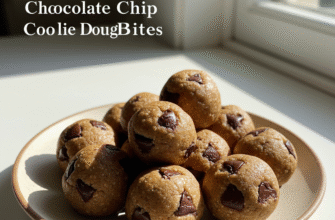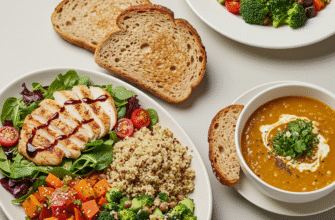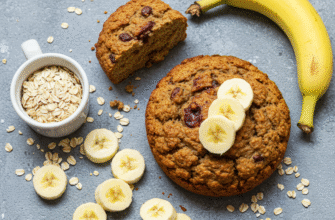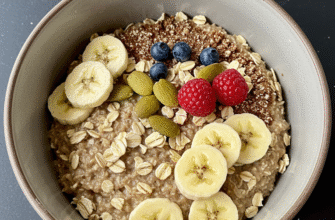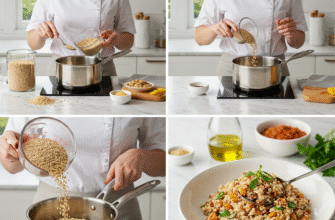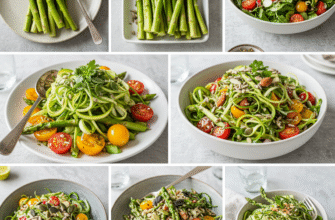Feeling that mid-afternoon slump? Before reaching for that sugary treat or bag of salty crisps, consider powering up your snack time with fiber. High-fiber snacks aren’t just about keeping your digestion running smoothly; they offer a surprising range of benefits that can help you feel more energized, satisfied, and ready to tackle the rest of your day. Moving away from empty calories towards nutrient-dense, fiber-rich options can be a simple yet effective tweak to your eating habits.
Fiber, a type of carbohydrate that the body can’t digest, plays a crucial role in our overall well-being. It helps regulate the body’s use of sugars, helping to keep hunger and blood sugar in check. Snacks packed with this nutrient release energy more slowly than their low-fiber, high-sugar counterparts. This means you avoid the notorious sugar rush followed by a crash, enjoying sustained energy instead. Furthermore, fiber adds bulk, which contributes to a feeling of fullness or satiety. This can be incredibly helpful if you find yourself constantly battling the munchies between meals.
Why Make the Switch to High-Fiber Snacking?
Choosing snacks high in fiber is a smart move for several reasons. Beyond the sustained energy release and increased feeling of fullness, these snacks often come packaged with other essential nutrients. Think vitamins, minerals, and antioxidants found abundantly in fruits, vegetables, nuts, and seeds – common high-fiber heroes. Incorporating these into your snack routine contributes positively to your overall nutrient intake.
Another significant advantage is supporting your digestive system. Fiber helps keep things moving regularly, contributing to gut comfort. It acts like a workout for your digestive tract, promoting regularity in a natural way. Opting for fiber-rich snacks is essentially choosing food that works *with* your body, providing fuel and function simultaneously.
Delicious & Easy High-Fiber Snack Ideas
The great news is that high-fiber snacks don’t have to be boring or complicated. Nature provides an incredible array of delicious and convenient options. Let’s explore some easy ways to boost your fiber intake during snack time.
Fruits and Vegetables: Nature’s Fast Food
Fruits and vegetables are perhaps the easiest way to get a quick fiber fix. They require minimal preparation and are bursting with flavor and nutrients.
- Apples or Pears (with skin): The skin is where a significant amount of fiber resides. Slice up an apple or pear for a crisp, refreshing, and fibrous snack. Pair with a tablespoon of nut butter for added protein and healthy fats.
- Berries: Raspberries and blackberries are fiber superstars. Enjoy a bowl on their own, mix them into yogurt, or add them to a small portion of oatmeal.
- Raw Veggies with Hummus: Think carrot sticks, celery sticks, bell pepper strips, cucumber slices, or cherry tomatoes. Dip them in hummus, which is made from chickpeas (another fiber source), for a satisfying and crunchy snack.
- Edamame: These young soybeans, often served steamed in their pods, are fun to eat and provide a good dose of fiber and plant-based protein. Look for them in the frozen section.
- Avocado: Mash half an avocado onto a slice of whole-wheat toast or a couple of whole-grain crackers. Avocado delivers healthy fats alongside a surprising amount of fiber.
Nuts, Seeds, and Legumes: Tiny Powerhouses
Don’t underestimate the fiber content of these small but mighty foods. They are dense in nutrients and incredibly versatile.
- A Handful of Nuts: Almonds, walnuts, pistachios, and pecans are excellent choices. Stick to a small handful (about a quarter cup) as they are calorie-dense. Choose unsalted or lightly salted varieties.
- Chia Seed Pudding: Prepare this the night before for a grab-and-go snack. Mix chia seeds with milk (dairy or plant-based) and a touch of sweetener if desired. The seeds absorb the liquid and create a pudding-like consistency, packed with fiber and omega-3 fatty acids.
- Roasted Chickpeas: Drain and rinse a can of chickpeas, toss with a little olive oil and your favorite spices (like paprika, cumin, or garlic powder), and roast until crispy. A crunchy, savory, high-fiber alternative to chips.
- Trail Mix (DIY): Combine your favorite nuts, seeds (like pumpkin or sunflower seeds), and a small amount of dried fruit (watch portion sizes due to sugar content). Making your own gives you control over the ingredients.
Whole Grains and Other Satisfying Options
Whole grains retain their bran and germ, which means they keep their fiber content intact. Look for “whole grain” or “whole wheat” as the first ingredient on labels.
- Air-Popped Popcorn: Popcorn is a whole grain! Opt for air-popped or make it on the stovetop with minimal oil and salt for a high-volume, high-fiber snack. Three cups of air-popped popcorn can provide a decent fiber boost.
- Whole-Wheat Crackers: Choose crackers made from 100% whole wheat or other whole grains. Pair them with cheese, avocado, or hummus for a more substantial snack.
- Small Bowl of Oatmeal: Oatmeal isn’t just for breakfast. A small, half-cup (cooked) portion can be a warming and fiber-rich snack, especially when topped with berries or seeds.
- Greek Yogurt with Toppings: While yogurt itself isn’t high in fiber, using it as a base for high-fiber toppings like berries, chia seeds, flax seeds, or a sprinkle of high-fiber granola creates a protein and fiber-packed snack.
Important Note on Increasing Fiber: When adding more fiber to your diet, do it gradually. A sudden large increase can sometimes cause temporary bloating or discomfort. Also, ensure you are drinking plenty of water throughout the day. Fiber works best when it absorbs water, which helps it move smoothly through your digestive system.
Making High-Fiber Snacking a Habit
Knowing the options is one thing; incorporating them consistently is another. Planning is key. Keep high-fiber snacks visible and accessible – a fruit bowl on the counter, pre-portioned nuts in your bag, or cut veggies in the fridge. When grocery shopping, make a conscious effort to stock up on these items.
Reading nutrition labels can also be helpful. Look for the ‘Dietary Fiber’ line under ‘Total Carbohydrates’. Aim for snacks that provide at least 3-5 grams of fiber per serving. This simple check can guide you towards better choices.
Finally, listen to your body. Experiment with different high-fiber snacks to find the ones you genuinely enjoy. Snacking should be satisfying, not a chore. By choosing options you love, you’re more likely to stick with this healthy habit long-term. Embracing high-fiber snacks is a simple, effective way to boost your energy, improve satiety, and support your overall well-being, one delicious bite at a time.

